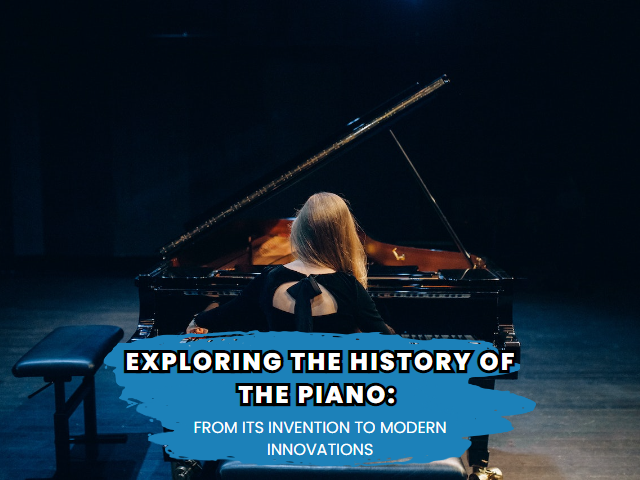
The piano is one of the most beloved and widely recognized musical instruments in the world. Its unique sound and versatility have made it a staple of classical music, as well as a favorite of pop and rock musicians. But where did the piano come from, and how has it evolved over the years? In this article, we will explore the fascinating history of the piano, from its invention to modern innovations.
Introduction
The piano was invented in Italy in the early 1700s by Bartolomeo Cristofori. It quickly gained popularity across Europe, and by the 1800s, it had become a standard fixture in households and concert halls alike. Over the years, the piano has undergone many changes and innovations, leading to the development of a wide range of styles and types.
Early history of the piano
Invention of the piano
Bartolomeo Cristofori’s invention of the piano was a significant moment in the history of music. His creation was a response to the limitations of the harpsichord, which was unable to produce the dynamic range and expressiveness that he desired. Cristofori spent many years experimenting with different designs and techniques before he finally developed the first piano.
The first pianos, known as “pianofortes,” were quite different from modern pianos. They were smaller and had a lighter touch, and their strings were made of gut rather than steel. However, even in these early versions, Cristofori’s innovation was apparent. He had created an instrument that could produce a wider range of dynamics and expressiveness than any other keyboard instrument before it.
Over the next few decades, the piano continued to evolve, with new features such as pedals, a wider range of keys, and a stronger frame that allowed for greater tension on the strings. These innovations allowed for even greater expression and power, and by the 1800s, the piano had become a standard fixture in households and concert halls alike.
Early pianos
The first pianos, known as “pianofortes,” were quite different from modern pianos. They were smaller and had a lighter touch, and their strings were made of gut rather than steel.
Development of the piano
Over the next few decades, the piano continued to evolve, with new features such as pedals, a wider range of keys, and a stronger frame that allowed for greater tension on the strings.
The piano in the 19th century
The golden age of piano making
The 19th century saw the piano reach new heights of popularity and innovation. Piano makers such as Steinway & Sons and Bechstein developed new techniques and designs that allowed for even greater power, expression, and range.
The rise of virtuoso pianists
The 19th century also saw the rise of virtuoso pianists, such as Franz Liszt and Frederic Chopin, who pushed the limits of what the piano could do and helped to establish it as a solo instrument.
The development of different types of pianos
The 19th century also saw the development of different types of pianos, such as upright pianos and grand pianos, which allowed for greater versatility and accessibility. If you’d like to try some different kinds of piano book a trial with us to experience the instrument and see if you’d like to take some lessons here!
The piano in the 20th century
The introduction of the player piano
In the early 20th century, the player piano was introduced, which allowed people to listen to pre-recorded music on a piano. This technology would later evolve into the modern electronic keyboard.
The rise of jazz and popular music
The piano continued to be a popular instrument in classical music, but it also found a new home in jazz and popular music. Pianists such as Duke Ellington and George Gershwin brought new styles and techniques to the instrument.
Innovations in piano design
Throughout the 20th century, there were many innovations in piano design, such as the introduction of aluminum frames and composite materials that made pianos lighter and more affordable.
Modern innovations in piano technology
The digital piano
In recent years, digital pianos have become increasingly popular, with many musicians preferring their versatility and portability.
Hybrid pianos
Hybrid pianos are a relatively new development in the world of pianos. They combine the best of acoustic and digital technology, creating an instrument that has the sound and feel of a traditional piano with the convenience and versatility of digital technology.
Hybrid pianos typically feature a traditional acoustic piano soundboard and strings, but they also include digital components such as speakers, amplifiers, and MIDI interfaces. This allows the pianist to control various digital effects and sounds, as well as record and play back their performances.
One of the advantages of hybrid pianos is their versatility. They can be used in a wide range of settings, from small practice rooms to large concert halls. They are also more affordable than traditional acoustic pianos, making them an attractive option for students and beginners.
Hybrid pianos come in many different styles and designs, from grand pianos to upright pianos to portable digital keyboards. Some models even allow for wireless connectivity, allowing the pianist to control the instrument from a smartphone or tablet.
Despite their many advantages, some purists argue that hybrid pianos lack the authenticity and tonal richness of traditional acoustic pianos. However, for many pianists and music enthusiasts, hybrid pianos offer the best of both worlds, combining the beauty and warmth of acoustic sound with the convenience and versatility of digital technology.
Conclusion
The piano has come a long way since its invention in the early 1700s. From its humble beginnings as a small, experimental instrument to its status as a beloved and versatile instrument, the piano has undergone many changes and innovations throughout history. Today, pianos come in many different styles and designs, from traditional acoustic grand pianos to modern digital keyboards. Despite all these changes, the piano continues to captivate audiences and inspire musicians around the world.
FAQs
Q: What is the difference between a grand piano and an upright piano?
A: A grand piano has the strings and soundboard placed horizontally, whereas an upright piano has them placed vertically. This difference affects the sound quality and touch of the piano.
Q: Can a digital piano replicate the sound of an acoustic piano?
A: Yes, modern digital pianos use advanced sampling and modeling technology to replicate the sound and feel of an acoustic piano.
Q: Who was the most famous pianist of the 19th century?
A: There were many famous pianists in the 19th century, but Franz Liszt and Frederic Chopin are widely regarded as two of the greatest.
Q: How do you tune a piano?
A: Piano tuning is a complex process that involves adjusting the tension of the strings to ensure they are in tune with each other. It is typically done by a professional piano tuner.
Q: Can you learn to play the piano on a digital keyboard?
A: Yes, a digital keyboard can be a great tool for learning to play the piano. However, it is important to eventually transition to a traditional piano in order to develop proper technique and touch.
Exploring the history of the piano: From its invention to modern innovations





